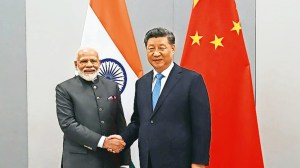Stay updated with the latest - Click here to follow us on Instagram
In address to Congress, Trump slams India’s high tariffs, warns of US retaliation: ‘System is not fair to us’
Trump Speech to Congress Crucial Announcements: President Trump’s address also carried a crucial announcement: the imposition of reciprocal tariffs would begin on April 2, aimed at levelling the playing field for American exporters.
 Donald Trump addressing a joint session of Congress on Tuesday night. (Reuters)
Donald Trump addressing a joint session of Congress on Tuesday night. (Reuters)Trump Address to Congress Announcements: In a pivotal speech addressing a joint session of Congress, US President Donald Trump made a pointed reference to India as he underscored his administration’s commitment to enforcing reciprocal tariffs on foreign imports. The mention of India, alongside China and the European Union, during Trump’s rhetoric on trade marks a significant moment in the intensifying trade tensions between the United States and its global counterparts. His remarks spotlighted the idea of “fair trade,” with Trump asserting that India and other nations have long imposed excessive tariffs on American goods, particularly autos, to the detriment of US businesses.
Speaking forcefully before a packed House of Representatives, Trump expressed his dissatisfaction with what he described as lopsided trade practices, calling for swift action. “Other countries have used tariffs against us for decades, and now it’s our turn to start using them against those other countries,” Trump declared, reinforcing his “America First” approach. He specifically pointed to India’s high tariff rates, stating, “India charges us tariffs, 100 per cent. The system is not fair to the US, it never was.”
Reciprocal tariffs to take effect in April
President Trump’s address also carried a crucial announcement: the imposition of reciprocal tariffs would begin on April 2, aimed at levelling the playing field for American exporters. Under this new policy, the US plans to impose equivalent tariffs on countries that levy high duties on American goods. Trump explained, “Whatever they tariff us, we will tariff them. Whatever they tax us, we will tax them. If they use non-monetary barriers to keep us out of their market, we will do the same.”
While details of the tariffs remain unclear, experts predict that these measures could disproportionately affect India, given the nation’s higher-than-average tariffs on several categories of US imports. Among the most glaring disparities highlighted in Trump’s speech is India’s 100 per cent tariff on imported American automobiles, a longstanding point of contention between the two nations.
Impact of reciprocal tariffs on India
The prospect of reciprocal tariffs raises concerns about potential disruptions to India-US trade relations, which have grown increasingly robust over the past decade. India’s tariff rates, while aligned with its protective economic strategy, are significantly higher than those of the US, especially in key sectors such as agriculture, textiles, and pharmaceuticals.
Goldman Sachs, in a recent report, pointed out that the implementation of reciprocal tariffs could impact India on three different levels: at a country level, product level, or through non-tariff barriers. The report stated that reciprocity at the country level — where tariffs are broadly applied — would be the simplest approach for the US to adopt, though the precise economic impact would depend on the scope and scale of the measures introduced.
At the product level, matching India’s tariffs on specific imports from the US could create an additional layer of complexity. According to Goldman Sachs, this could widen the average tariff differential by approximately 11.5 percentage points, potentially requiring a longer timeline to implement. While India’s high tariff on auto imports has garnered attention, other sectors like agriculture and electronics could also see new levies, which may strain trade flows between the two countries.
“Reciprocity through non-tariff barriers, such as administrative restrictions, import licenses, or export subsidies, would be the most complicated approach,” the report noted. “This could lead to even higher tariffs or restrictions at the product or country level and would create significant challenges in terms of compliance and enforcement.”
India’s exposure to tariffs
India’s growing trade surplus with the United States is also at stake as Trump’s administration pursues more aggressive trade policies. Over the last decade, India’s goods trade surplus with the US has doubled to $35 billion, which represents nearly 1 per cent of India’s GDP for the fiscal year ending in 2024. Much of this surplus has been driven by India’s strong exports in sectors like electronics, pharmaceuticals, and textiles, all of which could be vulnerable to reciprocal tariff measures.
Despite this, Goldman Sachs emphasized that India’s gross exports to the US, at around 2 per cent of GDP, remain relatively low compared to other emerging markets. The report estimated that an increase in US tariffs could shave 0.1 to 0.3 percentage points off India’s GDP growth, depending on the extent of tariff reciprocity and US demand elasticity for Indian goods.
However, the stakes rise significantly if Trump’s administration were to impose broader global tariffs, as has been threatened in the past. If such measures targeted all trading partners equally, India’s exposure to US final demand — including goods routed through third countries — could double, representing 4 per cent of India’s GDP. In such a scenario, the potential domestic growth impact could range between 0.1 and 0.6 percentage points.
As the April 2 deadline approaches, the global trade community will be watching closely to see how Trump’s reciprocal tariffs unfold and whether they lead to wider disruptions in international markets. For India, the stakes are high, and the challenge will be balancing the need to protect its domestic industries while avoiding an all-out trade conflict with the world’s largest economy.
Photos





- 01
- 02
- 03
- 04
- 05

























